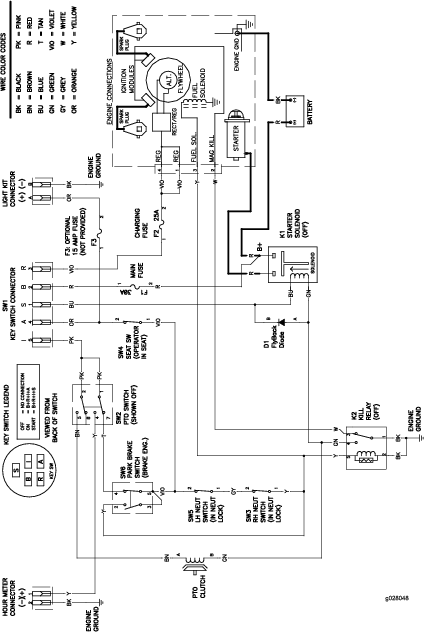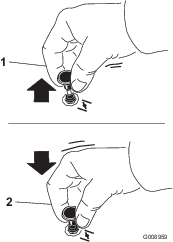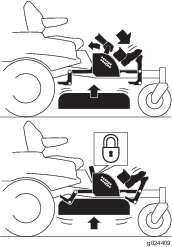| Maintenance Service Interval | Maintenance Procedure |
|---|---|
| Before each use or daily |
|
Introduction
Read this information carefully to learn how to operate and maintain your product properly and to avoid injury and product damage. You are responsible for operating the product properly and safely.
You may contact Toro directly at www.Toro.com for product safety and operation training materials, accessory information, help finding a dealer, or to register your product.
Whenever you need service, genuine Toro parts, or additional information, contact an Authorized Service Dealer or Toro Customer Service and have the model and serial numbers of your product ready. Figure 1 identifies the location of the model and serial numbers on the product. Write the numbers in the space provided.
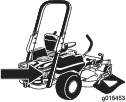
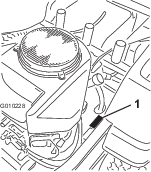
This manual identifies potential hazards and has safety messages identified by the safety alert symbol (Figure 2), which signals a hazard that may cause serious injury or death if you do not follow the recommended precautions.

This manual uses 2 other words to highlight information. Important calls attention to special mechanical information and Note emphasizes general information worthy of special attention.
Warning
Removing standard original equipment parts and accessories may alter the warranty, traction, and safety of the machine. Failure to use original Toro parts could cause serious injury or death. Making unauthorized changes to the engine, fuel or venting system, may violate EPA and CARB regulations.
Replace all parts including, but not limited to, tires, belts, blades, and fuel system components with original Toro parts.
For models with stated engine horsepower, the gross horsepower of the engine was laboratory rated by the engine manufacturer in accordance with SAE J1940 and rated to J2723.
Do not tamper with the engine controls or alter the governor speed; doing so may create an unsafe condition resulting in personal injury.
This machine is a ride-on, rotary-blade lawnmower intended to be used by homeowners in residential applications. It is primarily designed for cutting grass on well-maintained lawns. It is not designed for cutting brush, mowing grass and other growth alongside highways, or for agricultural uses.
This product complies with all relevant European directives, for details please see the separate product specific Declaration of Conformity (DOC) sheet.
Safety
The following instructions are from the EN standard EN ISO 5395:2013.
Safe Operation Practices for Ride-On (riding) Rotary Lawnmower Machines
This machine meets or exceeds European Standards in effect at the time of production. However, improper use or maintenance by the operator or owner can result in injury. To reduce the potential for injury, comply with these safety instructions and always pay attention to the safety alert symbol, which means Caution, Warning, or Danger -“personal safety instruction.” Failure to comply with the instruction may result in personal injury or death.
Safe Operating Practices
This product is capable of amputating hands and feet and throwing objects. Always follow all safety instructions to avoid serious injury or death.
Training
-
Read the instructions carefully. Be familiar with the controls and the proper use of the equipment.
-
Never allow children or people unfamiliar with these instructions to use the lawnmower. Local regulations can restrict the age of the operator.
-
Never mow while people, especially children, or pets are nearby.
-
Keep in mind that the operator or user is responsible for accidents or hazards occurring to other people or their property.
-
Do not carry passengers.
-
All drivers should seek and obtain professional and practical instruction. Such instruction should emphasize:
-
the need for care and concentration when working with ride-on machines;
-
control of a ride-on machine sliding on a slope will not be regained by the application of the brake. The main reasons for loss of control are:
-
insufficient wheel grip;
-
being driven too fast;
-
inadequate braking;
-
the type of machine is unsuitable for its task;
-
lack of awareness of the effect of ground conditions, especially slopes;
-
incorrect hitching and load distribution.
-
-
Preparation
-
While mowing, always wear substantial, slip-resistant footwear and long trousers. Do not operate the equipment when barefoot or wearing open sandals.
-
Thoroughly inspect the area where the equipment is to be used and remove all objects which may be thrown by the machine.
-
Warning-Fuel is highly flammable.
-
Store fuel in containers specifically designed for this purpose.
-
Refuel outdoors only and do not smoke while refueling.
-
Add fuel before starting the engine. Never remove the cap of the fuel tank or add fuel while the engine is running or when the engine is hot.
-
If fuel is spilled, do not attempt to start the engine but move the machine away from the area of spillage and avoid creating any source of ignition until fuel vapors have dissipated.
-
Replace all fuel tanks and container caps securely.
-
-
Replace faulty silencers.
-
Before using, always visually inspect to see that the blades, blade bolts and cutter assembly are not worn or damaged. Replace worn or damaged blades and bolts in sets to preserve balance.
-
On multi-bladed machines, take care as rotating one blade can cause other blades to rotate.
Operation
-
Be alert, slow down and use caution when making turns. Look behind and to the side before changing directions.
-
Do not operate the engine in a confined space where dangerous carbon monoxide fumes can collect.
-
Mow only in daylight or in good artificial light.
-
Before attempting to start the engine, disengage all blade attachment clutches and shift into neutral.
-
Do not use on slopes of more than 15 degrees.
-
Remember there is no such thing as a safe slope. Travel on grass slopes requires particular care. To guard against overturning:
-
do not stop or start suddenly when going up or downhill;
-
use low speeds on slopes and during tight turns;
-
stay alert for humps and hollows and other hidden hazards;
-
-
Use care when pulling loads.
-
Use only approved drawbar hitch points.
-
Limit loads to those you can safely control.
-
Do not turn sharply. Use care when reversing.
-
-
Watch out for traffic when crossing or near roadways.
-
Stop the blades rotating before crossing surfaces other than grass.
-
When using any attachments, never direct discharge of material toward bystanders nor allow anyone near the machine while in operation.
-
Never operate the machine with damaged guards or without safety protective devices in place.
-
Do not change the engine governor settings or overspeed the engine. Operating the engine at excessive speed can increase the hazard of personal injury.
-
Before leaving the operator's position:
-
disengage the power take-off and lower the attachments;
-
change into neutral and set the parking brake;
-
stop the engine and remove the key.
-
-
Disengage drive to attachments, stop the engine, and disconnect the spark plug wire(s) or remove the ignition key.
-
before clearing blockages or unclogging chute;
-
before checking, cleaning or working on the lawnmower;
-
after striking a foreign object. Inspect the lawnmower for damage and make repairs before restarting and operating the equipment;
-
if the machine starts to vibrate abnormally (check immediately).
-
-
Disengage drive to attachments when transporting or not in use.
-
Stop the engine and disengage drive to attachment.
-
before refuelling;
-
before removing the grass catcher;
-
before making height adjustment unless adjustment can be made from the operator's position.
-
-
Reduce the throttle setting during engine run-out and, if the engine is provided with a shut-off valve, turn the fuel off at the conclusion of mowing.
-
Lightning can cause severe injury or death. If lightning is seen or thunder is heard in the area, do not operate the machine; seek shelter.
Maintenance and Storage
-
Keep all nuts, bolts and screws tight to be sure the equipment is in safe working condition.
-
Never store the equipment with fuel in the tank inside a building where fumes can reach an open flame or spark.
-
Allow the engine to cool before storing in any enclosure.
-
To reduce the fire hazard, keep the engine, silencer, battery compartment and fuel storage area free of grass, leaves, or excessive grease.
-
Check the grass catcher frequently for wear or deterioration.
-
Replace worn or damaged parts for safety.
-
If the fuel tank has to be drained, this should be done outdoors.
-
When machine is to be parked, stored or left unattended, lower the cutting means.
Toro Riding Mower Safety
The following list contains safety information specific to Toro products or other safety information that you must know that is not included in the CEN standard.
-
Do not operate the engine in a confined space where dangerous carbon monoxide and other exhaust gasses can collect.
-
Keep hands, feet, hair and loose clothing away from attachment discharge area, underside of mower and any moving parts while engine is running.
-
Do not touch equipment or attachment parts which may be hot from operation. Allow to cool before attempting to maintain, adjust, or service.
-
Battery acid is poisonous and can cause burns. Avoid contact with skin, eyes and clothing. Protect your face, eyes, and clothing when working with a battery.
-
Battery gases can explode. Keep cigarettes, sparks, and flames away from battery.
-
Use only genuine Toro replacement parts to ensure that original standards are maintained.
-
Use only Toro-approved attachments.
Slope Operation
-
Do not mow slopes greater than 15 degrees.
-
Do not mow near drop-offs, ditches, steep banks, or water. Wheels dropping over edges can cause rollovers, which may result in serious injury, death, or drowning.
-
Do not mow slopes when grass is wet. Slippery conditions reduce traction and could cause sliding and loss of control.
-
Do not make sudden turns or rapid speed changes.
-
Use a walk behind mower and/or a hand trimmer near drop-offs, ditches, steep banks, or water.
-
Reduce speed and use extreme caution on slopes.
-
Remove or mark obstacles such as rocks, tree limbs, etc. from mowing area. Tall grass can hide obstacles.
-
Watch for ditches, holes, rocks dips, and rises that change the operating angle, as rough terrain could overturn the machine.
-
Avoid sudden starts when mowing uphill because the mower may tip backwards.
-
Be aware that loss of traction may occur going downhill. Weight transfer to the front wheels may cause drive wheels to slip and cause loss of braking and steering.
-
Always avoid sudden starting or stopping on a slope. If tires lose traction, disengage the blades and proceed slowly off the slope.
-
Follow the manufacturer's recommendations for wheel weights or counterweights to improve stability.
-
Use extreme care with grass catchers or other attachments. These can change the stability of the machine and cause loss of control.
Using the Rollover Protection System (ROPS)
-
Keep the roll bar in the raised and locked position and use the seat belt when operating the machine.
-
Be certain that the seat belt can be released quickly in the event of an emergency.
-
Be aware there is no rollover protection when the roll bar is down.
-
Check the area to be mowed and never fold the ROPS in areas where there are slopes, drop offs or water.
-
Lower the rollbar only when absolutely necessary. Do not wear the seat belt with the roll bar folded down.
-
Check carefully for overhead clearances (i.e. branches, doorways, electrical wires) before driving under any objects and do not contact them.
Model 74846
Sound Power
This unit has a guaranteed sound power level of 105 dBA, which includes an Uncertainty Value (K) of 1 dBA.
Sound power level was determined according to the procedures outlined in ISO 11094.
Sound Pressure
This unit has a sound pressure level at the operator’s ear of 92 dBA, which includes an Uncertainty Value (K) of 1 dBA.
Sound power level was determined according to the procedures outlined in EN ISO 5395:2013.
Hand-Arm Vibration
Measured vibration level for left hand = 4.8 m/s2
Measured vibration level for right hand = 4.4 m/s2
Uncertainty Value (K) = 2.4 m/s2
Measured values were determined according to the procedures outlined in EN ISO 5395:2013.
Whole Body Vibration
Measured vibration level = 0.39 m/s2
Uncertainty Value (K) = 0.19 m/s2
Measured values were determined according to the procedures outlined in EN ISO 5395:2013 (Riding & Stand-Ons).
Model 74848
Sound Power
This unit has a guaranteed sound power level of 105 dBA, which includes an Uncertainty Value (K) of 1 dBA.
Sound power level was determined according to the procedures outlined in ISO 11094.
Sound Pressure
This unit has a sound pressure level at the operator’s ear of 92 dBA, which includes an Uncertainty Value (K) of 1 dBA.
Sound power level was determined according to the procedures outlined in EN ISO 5395:2013.
Hand-Arm Vibration
Measured vibration level for left hand = 5.8 m/s2
Measured vibration level for right hand = 3.6 m/s2
Uncertainty Value (K) = 2.3 m/s2
Measured values were determined according to the procedures outlined in EN ISO 5395:2013.
Whole Body Vibration
Measured vibration level = 0.45 m/s2
Uncertainty Value (K) = 0.22 m/s2
Measured values were determined according to the procedures outlined in EN ISO 5395:2013 (Riding & Stand-Ons).
Slope Indicator
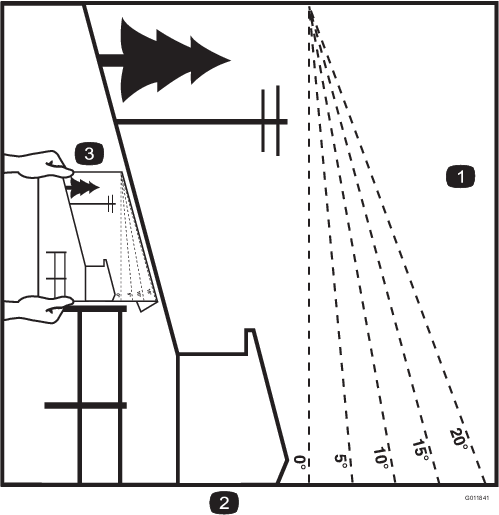
Safety and Instructional Decals
 |
Safety decals and instructions are easily visible to the operator and are located near any area of potential danger. Replace any decal that is damaged or lost. |





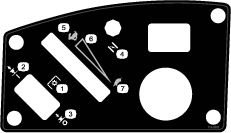
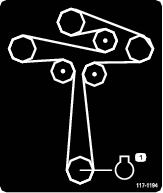
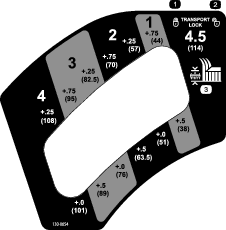


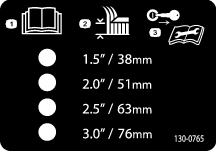
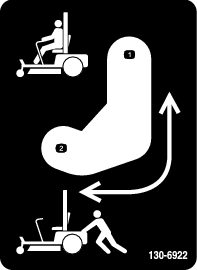
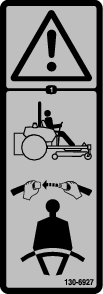
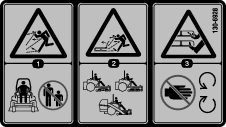


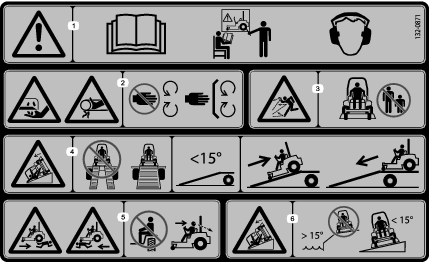
Product Overview
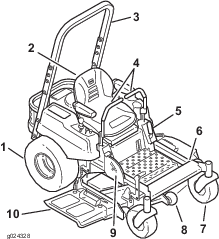
Become familiar with all the controls before you start the engine and operate the machine (Figure 5).
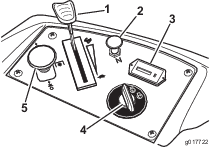
Ignition Switch
The ignition switch has three positions: Start, Run and Off. The key will turn to Start and move back to Run upon release. Turning the key to the Off position will stop the engine; however, always remove the key when leaving the machine to prevent the engine from accidentally starting (Figure 5).
Throttle Control
The throttle control is variable between Fast and Slow. Moving throttle lever forward will increase engine speed and moving throttle lever to the rear will decrease engine speed. Moving the throttle forward into the detent is full throttle (Figure 5).
Choke
Use the choke to start a cold engine. Pull the choke knob up to engage it. Push down on the choke knob to disengage it.
Blade-Control Switch (Power Take-Off)
The blade control switch, represented by a power take-off (PTO) symbol, engages and disengages power to the mower blades (Figure 5).
Hour Meter
The hour meter records the number of hours the blades have operated. It operates when the blade control switch (PTO) is engaged. Use these times for scheduling regular maintenance (Figure 5).
Fuel Gauge
The fuel window located below the operator position can be used to verify the level of gasoline in the tank (Figure 6).
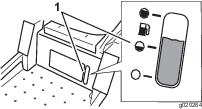
Motion Control Levers
The motion control levers are speed sensitive controls of independent wheel motors. Moving a lever forward or backward turns the wheel on the same side forward or in reverse; wheel speed is proportional to the amount the lever is moved. Move the control levers outward from the center to the neutral lock position and exit the machine (Figure 4). Always position the motion control levers into the neutral lock position when you stop the machine or leave it unattended.
Parking Brake Lever
Located on left side of the console (Figure 4). The brake lever engages a parking brake on the drive wheels. Pull the lever up and rearward to engage the brake. Push the lever forward and down to disengage the brake.
Foot Pedal Deck Lift System
The foot pedal deck lift system allows the operator to lower and raise the deck from the seated position. The operator can use the foot pedal to lift the deck briefly to avoid obstacles or lock the deck in the highest height-of-cut or transport position (Figure 4).
Height-of-Cut Lever
The height-of-cut lever works with the foot pedal to lock the deck in a specific cutting height. Only adjust the height of cut while machine is not moving (Figure 4).
Attachments/Accessories
A selection of Toro approved attachments and accessories is available for use with the machine to enhance and expand its capabilities. Contact your Authorized Service Dealer or Distributor or go to www.Toro.com for a list of all approved attachments and accessories.
Operation
Note: Determine the left and right sides of the machine from the normal operating position.
Adding Fuel
-
For best results, use only clean, fresh, unleaded gasoline with an octane rating of 87 or higher ((R+M)/2 rating method).
-
Oxygenated fuel with up to 10% ethanol or 15% MTBE by volume is acceptable.
-
Do Not use ethanol blends of gasoline (such as E15 or E85) with more than 10% ethanol by volume. Performance problems and/or engine damage may result which may not be covered under warranty.
-
Do Not use gasoline containing methanol.
-
Do Not store fuel either in the fuel tank or fuel containers over the winter unless a fuel stabilizer is used.
-
Do Not add oil to gasoline.
Danger
In certain conditions during fueling, static electricity can be released causing a spark which can ignite the gasoline vapors. A fire or explosion from gasoline can burn you and others and can damage property.
-
Always place gasoline containers on the ground away from your vehicle before filling.
-
Do not fill gasoline containers inside a vehicle or on a truck or trailer bed because interior carpets or plastic truck bed liners may insulate the container and slow the loss of any static charge.
-
When practical, remove gas-powered equipment from the truck or trailer and refuel the equipment with its wheels on the ground.
-
If this is not possible, then refuel such equipment on a truck or trailer from a portable container, rather than from a gasoline dispenser nozzle.
-
If a gasoline dispenser nozzle must be used, keep the nozzle in contact with the rim of the fuel tank or container opening at all times until fueling is complete.
Warning
Gasoline is harmful or fatal if swallowed. Long-term exposure to vapors can cause serious injury and illness.
-
Avoid prolonged breathing of vapors.
-
Keep face away from nozzle and gas tank or conditioner opening.
-
Keep gas away from eyes and skin.
Danger
In certain conditions, gasoline is extremely flammable and highly explosive. A fire or explosion from gasoline can burn you and others and can damage property.
-
Fill the fuel tank outdoors, in an open area, when the engine is cold. Wipe up any gasoline that spills.
-
Never fill the fuel tank inside an enclosed trailer.
-
Do not fill the fuel tank completely full. Add gasoline to the fuel tank until the level is 6 to 13 mm (1/4 to 1/2 inch) below the bottom of the filler neck. This empty space in the tank allows gasoline to expand.
-
Never smoke when handling gasoline, and stay away from an open flame or where gasoline fumes may be ignited by a spark.
-
Store gasoline in an approved container and keep it out of the reach of children. Never buy more than a 30-day supply of gasoline.
-
Do not operate without entire exhaust system in place and in proper working condition.
Using Stabilizer/Conditioner
Use a fuel stabilizer/conditioner in the machine to provide the following benefits:
-
Keeps gasoline fresh during storage of 90 days or less. For longer storage it is recommended that the fuel tank be drained.
-
Cleans the engine while it runs
-
Eliminates gum-like varnish buildup in the fuel system, which causes hard starting
Important: Do not use fuel additives containing methanol or ethanol.
Add the correct amount of gas stabilizer/conditioner to the gas.
Note: A fuel stabilizer/conditioner is most effective when mixed with fresh gasoline. To minimize the chance of varnish deposits in the fuel system, use fuel stabilizer at all times.
Fuel Gauge
Use the fuel window below the operator to verify the level of gasoline before filling the tank (Figure 7).

Filling the Fuel Tank
Make sure the engine is shut off and the motion controls are in the park position.
Important: Do Not overfill fuel tank. Fill the fuel tank to the bottom of the filler neck. The empty space in the tank allows the fuel to expand. Overfilling may result in fuel leakage or damage to the engine or emission system.
-
Clean around the fuel tank cap and remove the cap.
Note: You can use the fuel window below the operating position verify the presence of gasoline before filling the tank (Figure 7).
-
Slowly add regular, unleaded gasoline until the fuel reaches the base of the filler neck Figure 8.
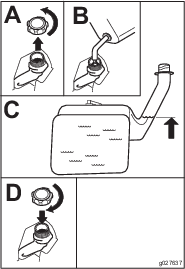
-
Install the fuel tank cap securely and tighten until it “clicks”. Wipe up any gasoline that may have spilled.
Think Safety First
Please carefully read all of the safety instructions and decals in the safety section. Knowing this information could help you, your family, pets or bystanders avoid injury.
Danger
Mowing on wet grass or steep slopes can cause sliding and loss of control.
Wheels dropping over edges can cause rollovers, which may result in serious injury, death or drowning.
A loss of traction is a loss of steering control.
To avoid loss of control and possibility of rollover:
-
Do not mow near drop-offs or near water.
-
Do not mow slopes greater than 15 degrees.
-
Reduce speed and use extreme caution on slopes.
-
When mowing slopes, gradually work from lower to higher areas on the incline.
-
Avoid sudden turns or rapid speed changes.
-
Turn up, into an incline when changing directions on slopes. Turning down the slope reduces traction.
-
Attachments change the handling characteristics of the machine. Use extra caution when using attachments with the machine.
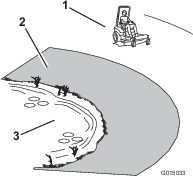
Caution
This machine produces sound levels in excess of 85 dBA at the operators ear and can cause hearing loss through extended periods of exposure.
Wear hearing protection when operating this machine.
The use of protective equipment for eyes, ears, hands, feet, and head is recommended.

Using the Rollover Protection System (ROPS)
Warning
To avoid injury or death from rollover: keep the roll bar installed and use the seat belt.
Warning
There is no rollover protection when the roll bar is removed.
-
Drive slowly and carefully.
-
Check carefully for overhead clearances (i.e. branches, doorways, electrical wires) before driving under any objects and do not contact them.
The Safety Interlock System
Warning
If safety interlock switches are disconnected or damaged the machine could operate unexpectedly causing personal injury.
-
Do not tamper with the interlock switches.
-
Check the operation of the interlock switches daily and replace any damaged switches before operating the machine.
Understanding the Safety Interlock System
The safety interlock system is designed to prevent the engine from starting unless:
-
The parking brake is engaged.
-
The blades are disengaged.
-
The motion control levers are in the neutral lock position.
The safety interlock system also is designed to stop the engine when the control levers are out of the neutral lock position with the parking brake on or if you rise from the seat when the blades are engaged.
Testing the Safety Interlock System
Test the safety interlock system before you use the machine each time. If the safety system does not operate as described below, have an Authorized Service Dealer repair the safety system immediately.
-
While sitting on the seat, engage the parking brake and move the blade control switch to On. Try starting the engine; the engine should not crank.
-
While sitting on the seat, engage the parking brake and move the blade control switch to Off. Move either motion control lever (forward or reverse). Try starting the engine; the engine should not crank. Repeat with the other motion control lever.
-
While sitting on the seat, engage the parking brake, move the blade control switch to Off, and lock the motion control levers in neutral. Start the engine. While the engine is running, release the parking brake, engage the blade control switch, and rise slightly from the seat; the engine should stop.
-
While sitting on the seat, engage the parking brake, move the blade control switch to Off, and lock the motion control levers in neutral. Start the engine. While the engine is running, center the motion controls; the engine should stop.
Checking the Engine Oil Level
Before you start the engine and use the machine, check the oil level in the engine crankcase; refer to Checking the Engine Oil Level.
Breaking in a New Machine
New engines take time to develop full power. Mower decks and drive systems have higher friction when new, placing additional load on the engine. Allow 40 to 50 hours of break-in time for new machines to develop full power and best performance.
Operating the Parking Brake
Always set the parking brake when you stop the machine or leave it unattended.
Setting the Parking Brake
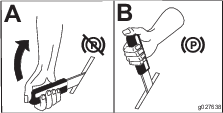
Releasing the Parking Brake
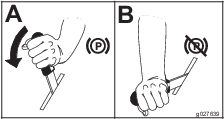
Operating the Throttle
The throttle control can be moved between Fast and Slow positions (Figure 13).
Always use the fast position when turning on the mower deck with the blade control switch (PTO).

Operating the Choke
Operating the Ignition Switch
-
Turn the ignition key to the Start position (Figure 15). When the engines starts, release the key.
Note: Additional starting cycles may be required when starting the engine for the first time after the fuel system has been without fuel completely.
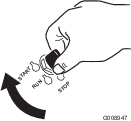
-
Turn the ignition key to stop to stop the engine.
Starting and Stopping the Engine
Starting the Engine
Note: A warm or hot engine may not require choking (Figure 16).
Important: Do not engage starter for more than 5 seconds at a time. If the engine fails to start allow a 15 second cool-down period between attempts. Failure to follow these instructions can burn out the starter motor.
Note: If the fuel system was depleted of fuel—add fuel to the machine and use additional starting cycles when starting the engine.
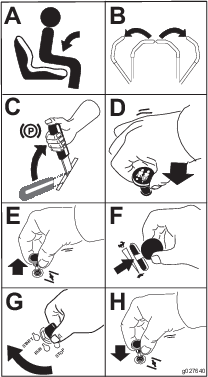
Stopping the Engine
Caution
Injury can occur if children or bystanders move or attempt to operate the machine while it is unattended.
Always remove the ignition key and set the parking brake when leaving the machine unattended, even if just for a few minutes.

Operating the Mower Blade Control Switch (PTO)
The blade control switch (PTO) starts and stops the mower blades and any powered attachments.
Engaging the Blade Control Switch (PTO)
Engage the blade control switch (PTO) with the throttle position at Fast.
Note: Engaging the blade control switch (PTO) with the throttle position at half or less will cause excessive wear to the drive belts.

Disengaging the Blade Control Switch (PTO)

Driving Forward or Backward
The throttle control regulates the engine speed as measured in rpm (revolutions per minute). Place the throttle control in the fast position for best performance. Always operate in the full throttle position when mowing.
Caution
Machine can spin very rapidly. Operator may lose control of machine and cause personal injury or damage to machine.
-
Use caution when making turns.
-
Slow the machine down before making sharp turns.
Using the Motion Control Levers

Driving Forward
Note: The engine will kill if the traction control levers are moved with the parking brake engaged.
-
Release the parking brake; refer to Releasing the Parking Brake in Operation.
-
Move the levers to the center, unlocked position.
-
To go forward, slowly push the motion control levers forward (Figure 21).
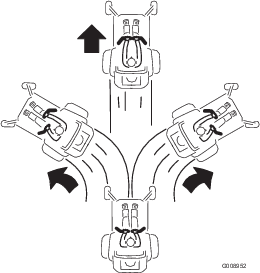
Driving Backward
Note: Always use caution when backing up and turning.
-
Move the levers to the center, unlocked position.
-
To go backward, slowly pull the motion control levers rearward (Figure 22).
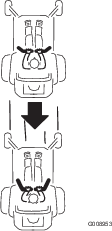
Stopping the Machine
Warning
Children or bystanders may be injured if they move or attempt to operate the machine while it is unattended.
Always remove the ignition key and move the motion control levers outward to the park position when leaving the machine unattended, even if just for a few minutes.
To stop the machine, move the traction control levers to neutral and move to locked position, disengage the blade control switch (PTO), and turn the ignition key to off.
Set the parking brake when you leave the machine; refer to Setting the Parking Brake. Remember to remove the key from the ignition switch.
Adjusting the Height-of-Cut
The machine is equipped with a foot pedal deck lift system. The operator can use the foot pedal to lift the deck briefly to avoid obstacles or lock the deck in the highest height-of-cut or transport position. The operator can use the height of cut lever with the foot pedal to lock the deck in a specific cutting height.
Using the Foot Pedal Deck Lift System
Adjusting the Height-of-Cut
The height-of-cut can be adjusted from 38 to 114 mm (1-1/2 to 4-1/2 inch) in 6 mm (1/4 inch) increments by relocating the height-of-cut pin into different hole locations.
-
Push on the deck lift pedal with your foot and raise the mower deck to the transport lock position (also the 114 mm (4-1/2 inch) cutting height position) (Figure 24).
-
To adjust, remove the pin from the height-of-cut bracket (Figure 24).
-
Select a hole in the height-of-cut system corresponding to the height-of-cut desired and insert the pin (Figure 24).
-
Push on the deck lift pedal with your foot and pull the handle rearward to disengage the transport lock (Figure 23).
-
Lower the deck slowly until the lever makes contact with the pin.
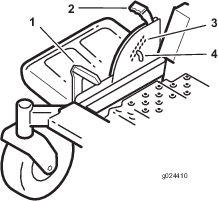
Adjusting the Anti-Scalp Rollers
Whenever you change the height-of-cut, it is recommended to adjust the height of the anti-scalp rollers.
-
Disengage the blade control switch (PTO), move the motion control levers to the neutral lock position and set the parking brake.
-
Stop the engine, remove the key, and wait for all moving parts to stop before leaving the operating position.
-
Remove the flange nut, anti-scalp roller and bolt from the bracket (Figure 25).
Note: Keep the bolt and anti-scalp roller together when removing.

-
Align the bolt and anti-scalp roller in the hole of the bracket that matched the closest height of cut position (Figure 25).
-
Insert the bolt into the bracket hole and secure the bolt and anti-scalp roller with the flange nut (Figure 25).
Positioning the Seat
The seat can move forward and backward. Position the seat where you have the best control of the machine and are most comfortable.
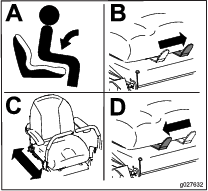
Adjusting the Motion Control Levers
Adjusting the Height
Note: Repeat the adjustment for the opposite control lever.
The motion control levers can be adjusted higher or lower for maximum operator comfort (Figure 27).
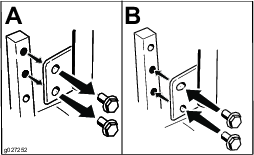
Adjusting the Tilt
The motion control levers can be tilted fore or aft for maximum operator comfort.
-
Loosen the upper bolt holding the control lever to the control arm shaft.
-
Loosen the lower bolt just enough to pivot the control lever fore or aft. Tighten both bolts to secure the control in the new position.
-
Repeat the adjustment for the opposite control lever.
Pushing the Machine by Hand
Important: Always push the machine by hand. Never tow the machine because damage may occur.
To Push the Machine
-
Park the machine on a level surface and disengage the blade control switch.
-
Move the motion control levers outward to neutral lock position, stop the engine, remove the key, and wait for all moving parts to stop before leaving the operating position. Make sure the parking brake is disengaged.
-
Do this procedure on each side of the machineFigure 28.
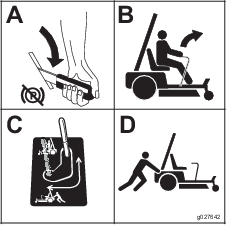
To Operate the Machine
Move the bypass to the position for operating the machine (Figure 28) to engage the wheel motors.
Converting the 48 inch Mower to Side Discharge
The mower deck and mower blades shipped with this machine were designed for optimum mulching and side discharge performance.
Install the fasteners into the same holes in the deck they were originally removed from. This ensure no holes are left open when the deck is operated.
Danger
Open holes in the mower expose you and others to thrown debris. Debris thrown out of holes in the mower can cause injury.
-
Never operate the mower without hardware mounted in all holes in the mower.
-
Install hardware in mounting holes when the baffle is removed.
Removing the Mulch Baffle
-
Park the machine on a level surface and disengage the blade control switch.
-
Move the motion control levers outward to the neutral lock position, set the parking brake, stop the engine, remove the key, and wait for all moving parts to stop before leaving the operating position.
-
Remove the mower as described in the Removing the Mower procedure in the Maintenance section for more information.
-
Turn the mower upside down.
-
Remove the existing mower blades installed on your deck. Refer to the Removing the Blades procedure in the Maintenance section for more information.
-
Remove the two locknuts (5/16 inch) secured to the welded posts of the left baffle on the top of the mower deck at the center and left of center positions (Figure 29). Remove the carriage bolt and locknut on the side wall of the mower deck securing the left baffle to the deck.
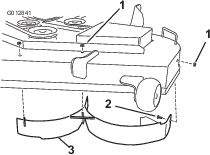
-
Remove the left baffle from the mower deck as shown in Figure 29.
-
Remove the carriage bolt (5/16 x 3/4 inch) and locknut (5/16 inch) on the rear wall of the mower deck securing the baffle to the deck (Figure 30).
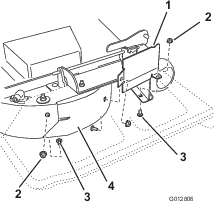
-
Locate the baffle guard at the front edge of the side discharge opening. Remove the fasteners securing the baffle guard and the right baffle to the mower deck as shown in Figure 30. Remove the baffle guard and retain all fasteners.
-
Remove the two locknuts (5/16 inch) to securing the welded posts of the right baffle to the top of the mower deck at center and right of center positions (Figure 31). Remove the right baffle from the mower deck.
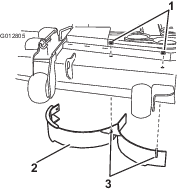
-
Locate the cut off baffle in the loose parts bag. Remove the fasteners at the rear holes of the discharge plate. Install the baffle at the side discharge opening on the mower deck (Figure 32).
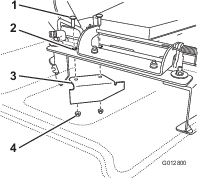
-
Use the fasteners removed to secure the cut off baffle to the deck.
-
Install the blades to the deck. Refer to the Installing the Blades procedure in the Maintenance section for more information.
-
Install the mower as described in the Installing the Mower procedure in the Maintenance section for more information.
Converting the 54 inch Mower to Side Discharge
Install the fasteners into the same holes in the deck they were originally removed from. This ensure no holes are left open when the deck is operated.
Danger
Open holes in the mower expose you and others to thrown debris. Debris thrown out of holes in the mower can cause injury.
-
Never operate the mower without hardware mounted in all holes in the mower.
-
Install hardware in mounting holes when the baffle is removed.
Removing the Mulch Baffle
-
Park the machine on a level surface and disengage the blade control switch.
-
Move the motion control levers outward to the neutral lock position, set the parking brake, stop the engine, remove the key, and wait for all moving parts to stop before leaving the operating position.
-
Remove the mower as described in the Removing the Mower procedure in the Maintenance section for more information.
-
Turn the mower upside down.
-
Remove the existing mower blades installed on your deck. Refer to the Removing the Blades procedure in the Maintenance section for more information.
-
Remove the three locknuts (5/16 inch) secured to the welded posts of the left baffle on the top of the mower deck at the center, left of center and left positions (Figure 33). Remove the carriage bolt and locknut on the side wall of the mower deck securing the left baffle to the deck.
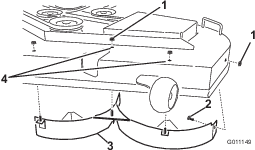
-
Remove the left baffle from the mower deck as shown in Figure 33.
-
Locate the two bolts in loose parts and use the existing locknuts. Install these fasteners into the holes shown in Figure 33 on the mower deck to prevent flying debris. Install the bolt up, through the underside of the deck and use an existing locknut to secure from the topside.
Warning
Open holes in the mower expose you and others to thrown debris which can cause severe injury.
-
Never operate the mower without hardware mounted in all holes in the mower housing.
-
Install the hardware in the mounting holes when you remove the mulching baffle.
-
-
Remove the carriage bolt (5/16 x 3/4 inch) and locknut (5/16 inch) on the rear wall of the mower deck securing the baffle to the deck (Figure 34).
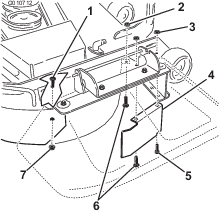
-
Locate the baffle guard at the front edge of the side discharge opening. Remove the fasteners securing the baffle guard and the right baffle to the mower deck as shown in Figure 34. Remove the baffle guard and retain all fasteners.
-
Remove the two locknuts (5/16 inch) securing the welded posts of the right baffle to the top of the mower deck at center and right of center positions (Figure 35).
-
Remove the carriage bolt and locknut securing the right baffle to the top of the mower deck. Remove the right baffle from the mower deck (Figure 35).
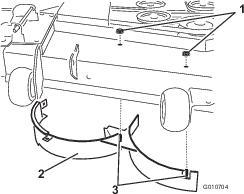
-
Install the fasteners removed previously at the front holes in the discharge plate and forward hole in the deck (Figure 34).
-
Locate the cut off baffle in the loose parts bag. Remove the fasteners at the rear holes of the discharge plate. Install the baffle at the side discharge opening on the mower deck (Figure 36).
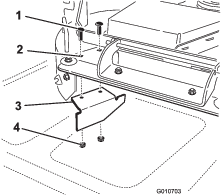
-
Use the fasteners removed to secure the cut off baffle to the deck.
-
Install the blades to the deck. Refer to the Installing the Blades procedure in the Maintenance section for more information.
-
Install the mower as described in the Installing the Mower procedure in the Maintenance section for more information.
Using the Side Discharge
The mower has a hinged grass deflector that disperses clippings to the side and down toward the turf.
Danger
Without a grass deflector, discharge cover, or complete grass catcher assembly mounted in place, you and others are exposed to blade contact and thrown debris. Contact with rotating mower blade(s) and thrown debris will cause injury or death.
-
Never remove the grass deflector from the mower because the grass deflector routes material down toward the turf. If the grass deflector is ever damaged, replace it immediately.
-
Never put your hands or feet under the mower.
-
Never try to clear the discharge area or mower blades unless you move the blade control switch (PTO) to the off position, rotate the ignition key to off and remove the key.
-
Make sure the grass deflector is in the down position.
Transporting the Machine
Use a heavy-duty trailer or truck to transport the machine. Ensure that the trailer or truck has all necessary brakes, lighting, and marking as required by law. Please carefully read all the safety instructions. Knowing this information could help you, your family, pets, or bystanders avoid injury.
Warning
Driving on the street or roadway without turn signals, lights, reflective markings, or a slow moving vehicle emblem is dangerous and can lead to accidents causing personal injury.
Do not drive machine on a public street or roadway.
To transport the machine:
-
If using a trailer, connect it to the towing vehicle and connect the safety chains.
-
If applicable, connect the trailer brakes.
-
Load the machine onto the trailer or truck.
-
Stop the engine, remove the key, set the brake, and close the fuel valve.
-
Tie down the machine near the front caster wheels and the rear bumper (Figure 37).
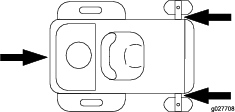
Loading the Machine
Use extreme caution when loading or unloading machines onto a trailer or a truck. Use a full-width ramp that is wider than the machine for this procedure. Back up ramps and drive forward down ramps (Figure 38).

Important: Do not use narrow individual ramps for each side of the machine.
Ensure the ramp is long enough so that the angle with the ground does not exceed 15 degrees (Figure 39). On flat ground, this requires a ramp to be at least four times (4X) as long as the height of the trailer or truck bed to the ground. A steeper angle may cause mower components to get caught as the unit moves from the ramp to the trailer or truck. Steeper angles may also cause the machine to tip or lose control. If loading on or near a slope, position the trailer or truck so that it is on the down side of the slope and the ramp extends up the slope. This will minimize the ramp angle.
Warning
Loading a machine onto a trailer or truck increases the possibility of tip-over and could cause serious injury or death.
-
Use extreme caution when operating a machine on a ramp.
-
Ensure that the ROPS is in the up position and use the seat belt when loading or unloading the machine. Ensure that the ROPS will clear the top of an enclosed trailer.
-
Use only a full-width ramp; do not use individual ramps for each side of the machine.
-
Do not exceed a 15-degree angle between the ramp and the ground or between the ramp and the trailer or truck.
-
Ensure the length of ramp is at least four times (4X) as long as the height of the trailer or truck bed to the ground. This will ensure that ramp angle does not exceed 15 degrees on flat ground.
-
Back up ramps and drive forward down ramps.
-
Avoid sudden acceleration or deceleration while driving the machine on a ramp as this could cause a loss of control or a tip-over situation.
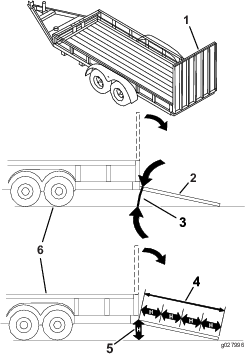
Operating Tips
Fast Throttle Setting
For best mowing and maximum air circulation, operate the engine at the fast throttle position. Air is required to thoroughly cut grass clippings, so do not set the height-of-cut so low as to totally surround the mower by uncut grass. Always try to have one side of the mower free from uncut grass, which allows air to be drawn into the mower.
Cutting a Lawn for the First Time
Cut grass slightly longer than normal to ensure the cutting height of the mower does not scalp any uneven ground. However, the cutting height used in the past is generally the best one to use. When cutting grass longer than 15.24 cm (6 inches) tall, you may want to cut the lawn twice to ensure an acceptable quality of cut.
Cut 1/3 of the Grass Blade
It is best to cut only about 1/3 of the grass blade. Cutting more than that is not recommended unless grass is sparse, or it is late fall when grass grows more slowly.
Mowing Direction
Alternate mowing direction to keep the grass standing straight. This also helps disperse clippings which enhances decomposition and fertilization.
Mow at Correct Intervals
Normally, mow every four days. But remember, grass grows at different rates at different times. So to maintain the same cutting height, which is a good practice, mow more often in early spring. As the grass growth rate slows in mid summer, mow less frequently. If you cannot mow for an extended period, first mow at a high cutting height; then mow again two days later at a lower height setting.
Cutting Speed
To improve cut quality, use a slower ground speed in certain conditions.
Avoid Cutting Too Low
If the cutting width of the mower is wider than the mower you previously used, raise the cutting height to ensure that uneven turf is not cut too short.
Long Grass
If the grass is ever allowed to grow slightly longer than normal, or if it contains a high degree of moisture, raise the cutting height higher than usual and cut the grass at this setting. Then cut the grass again using the lower, normal setting.
When Stopping
If the machine's forward motion must be stopped while mowing, a clump of grass clippings may drop onto your lawn. To avoid this, move onto a previously cut area with the blades engaged or you can disengage the mower deck while moving forward.
Keep the Underside of the Mower Clean
Clean clippings and dirt from the underside of the mower after each use. If grass and dirt build up inside the mower, cutting quality will eventually become unsatisfactory.
Blade Maintenance
Maintain a sharp blade throughout the cutting season because a sharp blade cuts cleanly without tearing or shredding the grass blades. Tearing and shredding turns grass brown at the edges, which slows growth and increases the chance of disease. Check the cutter blades daily for sharpness, and for any wear or damage. File down any nicks and sharpen the blades as necessary. If a blade is damaged or worn, replace it immediately with a genuine TORO replacement blade.
Maintenance
Recommended Maintenance Schedule(s)
| Maintenance Service Interval | Maintenance Procedure |
|---|---|
| After the first 8 hours |
|
| After the first 50 hours |
|
| Before each use or daily |
|
| After each use |
|
| Every 25 hours |
|
| Every 50 hours |
|
| Every 100 hours |
|
| Every 200 hours |
|
| Every 400 hours |
|
| Monthly |
|
| Yearly or before storage |
|
Important: Refer to your engine operator's manual for additional maintenance procedures.
Caution
If you leave the key in the ignition switch, someone could accidently start the engine and seriously injure you or other bystanders.
Remove the key from the ignition and disconnect the wire from the spark plug before you do any maintenance. Set the wire aside so that it does not accidentally contact the spark plug.
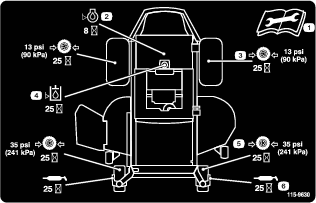
Pre-Maintenance Procedures
Raising the Seat
Make sure the motion control levers are locked in the neutral lock position. Lift the seat forward.
The following components can be accessed by raising the seat:
-
Service decal
-
Fuses
-
Battery and cables
Releasing the Mower-Deck Curtain
Loosen the 2 bottom bolts of the curtain to gain access to the top of the mower deck (Figure 41).
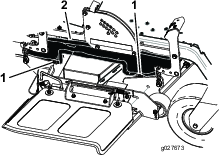
Lubrication
Greasing the Bearings
| Maintenance Service Interval | Maintenance Procedure |
|---|---|
| Every 25 hours |
|
Grease Type: No. 2 general purpose lithium base grease
-
Park the machine on a level surface and disengage the blade control switch.
-
Move the motion control levers outward to the neutral lock position, stop the engine, remove the key, and wait for all moving parts to stop before leaving the operating position.
-
Clean the grease fittings (Figure 42 and Figure 40) with a rag. Make sure to scrape any paint off of the front of the fitting(s).
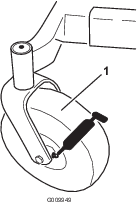
-
Connect a grease gun to each fitting (Figure 40 and Figure 42). Pump grease into the fittings until grease begins to ooze out of the bearings.
-
Wipe up any excess grease.
Engine Maintenance
Warning
Contact with hot surfaces may cause personal injury.
Keep hands, feet, face, clothing and other body parts away the muffler and other hot surfaces.
Servicing the Air Cleaner
Note: Service the air cleaner more frequently (every few hours) if operating conditions are extremely dusty or sandy.
Removing the Element
-
Park the machine on a level surface and disengage the blade control (PTO).
-
Move the motion control levers to the neutral lock position, set the parking brake, stop the engine, remove the key, and wait for all moving parts to stop before leaving the operating position.
-
Clean around the air cleaner cover to prevent dirt from getting into the engine and causing damage. Lift the cover and remove the hose clamp securing the air cleaner assembly to the engine (Figure 43).
-
Loosen the hose clamp and remove the paper element (Figure 43).
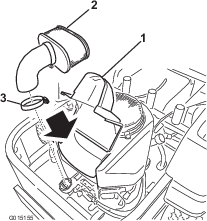
Cleaning the Element
| Maintenance Service Interval | Maintenance Procedure |
|---|---|
| Every 100 hours |
|
| Every 200 hours |
|
-
Lightly tap the element on a flat surface to remove dust and dirt.
-
Inspect the element for tears, an oily film, and damage to the seal.
Important: Never clean the paper element with pressurized air or liquids, such as solvent, gas, or kerosene. Replace the paper element if it is damaged or cannot be cleaned thoroughly.
Servicing the Engine Oil
Oil Type: Detergent oil (API service SF, SG, SH, SJ, or SL)
Crankcase Capacity: 1.8 liter (61 ounce); when oil filter is removed: 2.1 liter (70 ounce)
Viscosity: See the table below.
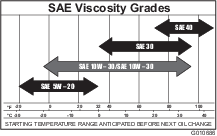
Note: Using multi grade oils (5W-20, 10W-30, and 10W-40) will increase oil consumption. Check oil level more frequently when using them.
Checking the Engine Oil Level
| Maintenance Service Interval | Maintenance Procedure |
|---|---|
| Before each use or daily |
|
Note: Check the oil when the engine is cold.
Warning
Contact with hot surfaces may cause personal injury.
Keep hands, feet, face, clothing and other body parts away the muffler and other hot surfaces.
Important: Do not overfill the crankcase with oil because damage to the engine may result. Do not run engine with oil below the low mark because the engine may be damaged.
-
Park the machine on a level surface, disengage the blade control switch, stop the engine, engage parking brake, and remove the key.
-
Make sure the engine is stopped, level, and is cool so the oil has had time to drain into the sump.
-
To keep dirt, grass clippings, etc., out of the engine, clean the area around the oil fill cap/dipstick before removing it.
-
Stop the engine, remove the key, and wait for all moving parts to stop before leaving the operating position (Figure 45).
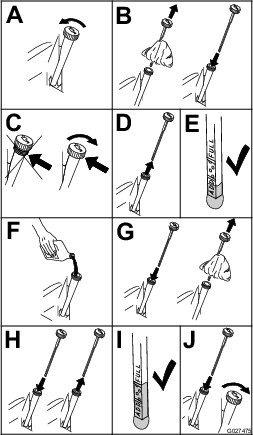
Changing the Engine Oil
| Maintenance Service Interval | Maintenance Procedure |
|---|---|
| After the first 8 hours |
|
| Every 100 hours |
|
Note: Dispose of the used oil at a recycling center.
-
Park the machine so that the drain side is slightly lower than the opposite side to ensure the oil drains completely.
-
Disengage the PTO, move the motion control levers to the neutral locked position and set the parking brake.
-
Stop the engine, remove the key, and wait for all moving parts to stop before leaving the operating position (Figure 46).
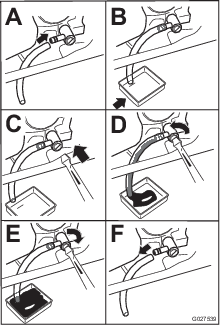
-
Slowly pour approximately 80% of the specified oil into the filler tube and slowly add the additional oil to bring it to the Full mark (Figure 47).
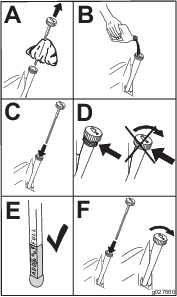
Changing the Engine Oil Filter
| Maintenance Service Interval | Maintenance Procedure |
|---|---|
| Every 200 hours |
|
Note: Change the engine oil filter more frequently when operating conditions are extremely dusty or sandy.
-
Drain the oil from the engine; refer to Changing the Engine Oil.
-
Change the engine oil filter (Figure 48).
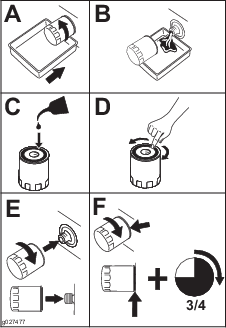
Note: Ensure the oil filter gasket touches the engine and then an extra 3/4 turn is completed.
-
Fill the crankcase with the proper type of new oil; refer to Changing the Oil.
Servicing the Spark Plug
| Maintenance Service Interval | Maintenance Procedure |
|---|---|
| Every 100 hours |
|
Make sure the air gap between the center and side electrodes is correct before installing the spark plug. Use a spark plug wrench for removing and installing the spark plug(s) and a gapping tool/feeler gauge to check and adjust the air gap. Install a new spark plug(s) if necessary.
Type: NGK BPR4ES (or equivalent)
Air Gap: 0.76 mm (0.030 inch)
Removing the Spark Plug
-
Disengage the PTO, move the motion control levers to the neutral locked position and set the parking brake.
-
Stop the engine, remove the key, and wait for all moving parts to stop before leaving the operating position.
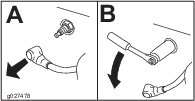
Note: Due to the deep recess around the spark plug, blowing out the cavity with compressed air is usually the most effective method for cleaning. The spark plug is most accessible when the blower housing is removed for cleaning.
Checking the Spark Plug
Important: Never clean the spark plug(s). Always replace the spark plug(s) when it has: a black coating, worn electrodes, an oily film, or cracks.
If you see light brown or gray on the insulator, the engine is operating properly. A black coating on the insulator usually means the air cleaner is dirty.
Set the gap to 0.030 inches (0.76 mm).
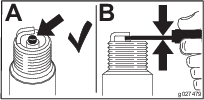
Installing the Spark Plug
Tighten the spark plug(s) to 22 N-m (16 ft-lb).
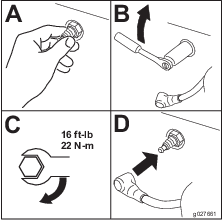
Cleaning the Cooling System
| Maintenance Service Interval | Maintenance Procedure |
|---|---|
| Before each use or daily |
|
Clean the air intake screen from grass and debris before each use.
-
Disengage the blade control switch and move the control levers to the neutral locked position and apply the parking brake.
-
Stop the engine, remove the key, and wait for all moving parts to stop before leaving the operating position.
-
Remove the air intake screen, air cleaner cover, and fan housing.
-
Clean debris and grass from the parts.
-
Install the air intake screen, air cleaner cover, and fan housing.
Fuel System Maintenance
Replacing the Fuel Filter
| Maintenance Service Interval | Maintenance Procedure |
|---|---|
| Every 100 hours |
|
-
Disengage the blade control switch (PTO), move the motion control levers to the neutral lock position, and set the parking brake.
-
Stop the engine, remove the key, and wait for all moving parts to stop before leaving the operating position.

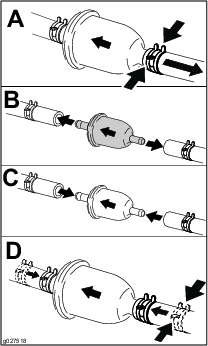
Electrical System Maintenance
Servicing the Battery
| Maintenance Service Interval | Maintenance Procedure |
|---|---|
| Monthly |
|
Danger
Battery electrolyte contains sulfuric acid which is a deadly poison and causes severe burns.
Do not drink electrolyte and avoid contact with skin, eyes or clothing. Wear safety glasses to shield your eyes and rubber gloves to protect your hands.
Removing the Battery
Warning
Battery terminals or metal tools could short against metal machine components causing sparks. Sparks can cause the battery gasses to explode, resulting in personal injury.
-
When removing or installing the battery, do not allow the battery terminals to touch any metal parts of the machine.
-
Do not allow metal tools to short between the battery terminals and metal parts of the machine.
Warning
Incorrect battery cable routing could damage the machine and cables causing sparks. Sparks can cause the battery gasses to explode, resulting in personal injury.
-
Always Disconnect the negative (black) battery cable before disconnecting the positive (red) cable.
-
Always Reconnect the positive (red) battery cable before reconnecting the negative (black) cable.
-
Disengage the blade control switch (PTO), move the motion control levers to the neutral lock position and set the parking brake.
-
Stop the engine, remove the key, and wait for all moving parts to stop before leaving the operating position.
-
Remove the wing nut securing the battery clamp (Figure 53).
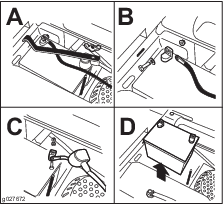
-
Remove the clamp (Figure 53).
-
First disconnect the negative battery cable (black) from the negative (-)(black) battery terminal (Figure 53).
-
Slide the red terminal boot off the positive (red) battery terminal and remove the positive (+)(red) battery cable (Figure 53).
-
Remove the battery.
Installing the Battery
-
Position battery in the tray with the terminal posts opposite from the fuel tank (Figure 53).
-
First, install the positive (red) battery cable to positive (+) battery terminal.
-
Then install the negative battery cable to the negative (-) battery terminal.
-
Secure the cables with 2 bolts, 2 washers, and 2 locknuts (Figure 53).
-
Slide the red terminal boot onto the positive (red) battery post.
-
Install the clamp and secure it with the wing nut (Figure 53).
Charging the Battery
Warning
Charging the battery produces gasses that can explode.
Never smoke near the battery and keep sparks and flames away from battery.
Important: Always keep the battery fully charged. This is especially important to prevent battery damage when the temperature is below 32°F (0°C).
-
Charge battery for 10 to 15 minutes at 25 to 30 amps or 30 minutes at 10 amps.
-
When the battery is fully charged, unplug the charger from the electrical outlet, then disconnect the charger leads from the battery posts (Figure 54).
-
Install the battery in the machine and connect the battery cables, refer to Installing the Battery.
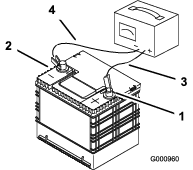
Servicing the Fuses
The electrical system is protected by fuses. It requires no maintenance; however if a fuse blows, check the component/circuit for a malfunction or short.
Note: The fuses are located on right hand console next to the seat (Figure 55).
Fuses:
-
Main, 30 amp, blade-type
-
Engine, 20 amp, blade-type
-
To replace the main fuse, grasp the fuse and pull it straight and away from the fuse block.
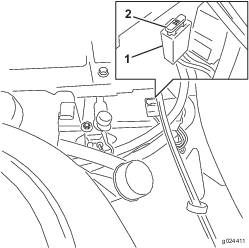
Important: Ensure that the new fuses are the same type and amperage as the fuses removed.
-
To replace the engine fuse, remove the console from the plastic fender.
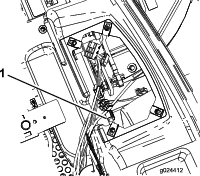
-
Grasp the engine fuse and pull it straight and away from the fuse block (Figure 56).
-
Align a new fuse with the slot in the fuse block (Figure 55).
-
Push the fuse into the fuse block until the fuse is seated (Figure 55).
Drive System Maintenance
Checking the Tire Pressure
| Maintenance Service Interval | Maintenance Procedure |
|---|---|
| Every 25 hours |
|
Maintain the air pressure in the front and rear tires as specified. Uneven tire pressure can cause uneven cut. Check the pressure at the valve stem (Figure 57). Check the tires when they are cold to get the most accurate pressure reading.
Refer to the maximum pressure suggested by the tire manufacturer on the sidewall of the caster wheel tires.
Inflate the rear drive wheel tires to 13 psi (90 kPa).

Hydraulic System Maintenance
Hydraulic System Oil Specification
Oil Type: Toro HYPR-OIL® 500 or 20w-50 motor oil.
System Capacity: approximately 4.495 liter (152 oz) with a filter change.
Important: Use oil specified or equivalent. Other fluids could cause system damage.
Checking the Hydraulic Oil Level
| Maintenance Service Interval | Maintenance Procedure |
|---|---|
| Every 25 hours |
|
Check expansion reservoir and if necessary add oil to the FULL COLD line.
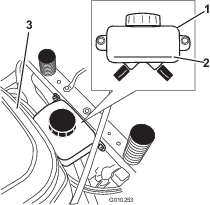
Changing the Hydraulic System Filter and Oil
The filter and oil are changed at the same time. Do Not reuse oil. Once the new filter is installed and oil is added any air in the system must be purged.
The bleeding process is repeated until the oil remains at the FULL COLD line in the reservoir after purging. Failure to properly perform this procedure can result in irreparable damage to the transaxle drive system.
Removing Hydraulic System Filters
Important: When the hydraulic oil filter is removed, all of the hydraulic oil in each transaxle will drain out. Use a container that will handle 4.495 liters (152 oz) or larger.
-
Stop engine, wait for all moving parts to stop, and allow engine to cool. Remove the key and engage the parking brake.
-
Locate the filter and guards on each transaxle drive system (Figure 59). Remove three screws securing the filter guard and guard.

-
Carefully clean the area around the filters. It is important that no dirt or contamination enter the hydraulic system.
-
Place a container below the filter to catch the oil that drains when the filter and vent plugs are removed.
-
Locate and remove the vent plug on each transmission
-
Unscrew the filter to remove and allow oil to drain from the drive system.
Repeat this procedure for both filters.
Installing the Hydraulic System Filters
| Maintenance Service Interval | Maintenance Procedure |
|---|---|
| After the first 50 hours |
|
| Every 400 hours |
|

-
Apply a thin coat of oil on the surface of the rubber seal of each filter.
-
Turn the filter clockwise until rubber seal contacts the filter adapter then tighten the filter an additional 3/4 to 1 full turn. Repeat for the other filter
-
Install the filter guards over each filter as previously removed. Use the three screws to secure the filter guards.
-
Verify the vent plugs are removed before adding the oil.
-
Slowly pour the specified oil through expansion reservoir until oil comes out of one of the vent plug holes. Stop and install that vent plug. Torque the plug to 20.3 N-m (180 in-lb).
-
Continue to add oil through the expansion reservoir until oil comes out of the remaining vent plug hole on the second transmission. Stop and install that vent plug. Torque the plug to 20.3 N-m (180 in-lb).
-
Continue to add oil through the expansion reservoir until it reaches the FULL COLD line on the expansion reservoir. Proceed to the Bleeding the Hydraulic System section.
Important: Failure to perform the Bleeding the Hydraulic System procedure after changing hydraulic filters and oil can result in irreparable damage to the transaxle drive system.
Bleeding the Hydraulic System
-
Raise the rear of machine up and support with jack stands (or equivalent support) just high enough to allow drive wheels to turn freely.
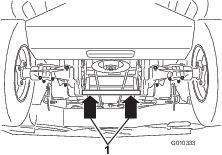
-
Enter the operator's position. Start engine and move throttle control ahead to 1/2 throttle position. Disengage parking brake.
-
Move the bypass levers into the pushing the machine position; refer to the Pushing the Machine by Hand section in Operation. With the bypass valves open and the engine running, slowly move the motion control levers in both forward and reverse (5 or 6 times).
-
Move the bypass levers into the operating the machine position. With the bypass valve closed and the engine running, slowly move the directional control in both forward and reverse directions (5 to 6 times).
-
Stop the engine and check the oil level in the expansion reservoir. Add the specified oil as until it reaches the FULL COLD line on the expansion reservoir.
-
-
Repeat step 2 until all the air is completely purged from the system.
When the transaxle operates at normal noise levels and moves smoothly forward and reverse at normal speeds, then the transaxle is considered purged.
-
Check the oil level in the expansion reservoir one last time. Add the specified oil as until it reaches the FULL COLD line on the expansion reservoir if necessary.
Mower Deck Maintenance
Servicing the Cutting Blades
Maintain sharp blades throughout the cutting season because sharp blades cut cleanly without tearing or shredding the grass blades. Tearing and shredding turns grass brown at the edges, which slows growth and increases the chance of disease.
Check the cutter blades daily for sharpness, and for any wear or damage. File down any nicks and sharpen the blades as necessary. If a blade is damaged or worn, replace it immediately with a genuine Toro replacement blade. For convenient sharpening and replacement, you may want to keep extra blades on hand.
Warning
A worn or damaged blade can break, and a piece of the blade could be thrown into the operator's or bystander's area, resulting in serious personal injury or death.
-
Inspect the blade periodically for wear or damage.
-
Replace a worn or damaged blade.
Before Inspecting or Servicing the Blades
Park the machine on a level surface, disengage the blade control switch (PTO), and set the parking brake. Turn the ignition key to Off. Remove the key.
Inspecting the Blades
| Maintenance Service Interval | Maintenance Procedure |
|---|---|
| Before each use or daily |
|
-
Inspect the cutting edges (Figure 62). If the edges are not sharp or have nicks, remove and sharpen the blades. Refer to Sharpening the Blades.
-
Inspect the blades, especially the curved area (Figure 62). If you notice any damage, wear, or a slot forming in this area (Figure 62), immediately install a new blade.
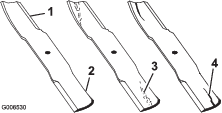
Checking for Bent Blades
Note: The machine must be on a level surface for the following procedure.
-
Raise the mower deck to the highest height-of-cut position; also considered the 'transport' position.
-
While wearing thickly padded gloves or other adequate hand protection slowly rotate blade to be measured into a position that allows effective measurement of the distance between the cutting edge and the level surface the machine is on.
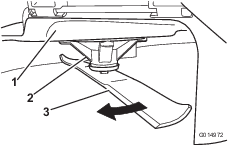
-
Measure from the tip of the blade to the flat surface here.

-
Rotate the same blade 180 degrees so that the opposing cutting edge is now in the same position.
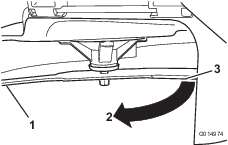
-
Measure from the tip of the blade to the flat surface here. The variance should be no more than 3 mm (1/8 inch).

Warning
A blade that is bent or damaged could break apart and could seriously injure or kill you or bystanders.
-
Always replace bent or damaged blade with a new blade.
-
Never file or create sharp notches in the edges or surfaces of blade.
-
If the difference between A and B is greater than 3 mm (1/8 inch) replace the blade with a new blade. Refer to Removing the Blades and Installing the Blades.
Note: If a bent blade is replaced with a new one and the dimension obtained continues to exceed 3 mm (1/8 inch), the blade spindle could be bent. Contact an Authorized Toro Dealer for service.
-
If the variance is within constraints, move to the next blade.
-
Repeat this procedure on each blade.
Removing the Blades
Blades must be replaced if a solid object is hit, if the blade is out of balance or is bent. To ensure optimum performance and continued safety conformance of the machine, use genuine Toro replacement blades. Replacement blades made by other manufacturers may result in non-conformance with safety standards.
Hold the blade end using a rag or thickly-padded glove. Remove the blade bolt, curved washer, and blade from the spindle shaft (Figure 67).
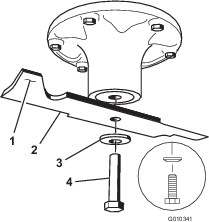
Sharpening the Blades
Warning
When sharpening blade, pieces of blade could be thrown and cause serious injury.
Wear proper eye protection when sharpening blade.
-
Use a file to sharpen the cutting edge at both ends of the blade (Figure 68). Maintain the original angle. The blade retains its balance if the same amount of material is removed from both cutting edges.

-
Check the balance of the blade by putting it on a blade balancer (Figure 69). If the blade stays in a horizontal position, the blade is balanced and can be used. If the blade is not balanced, file some metal off the end of the sail area only (Figure 67). Repeat this procedure until the blade is balanced.

Installing the Blades
-
Install the blade onto the spindle shaft (Figure 67).
Important: The curved part of the blade must be pointing upward toward the inside of the mower to ensure proper cutting.
-
Install the spring disk and blade bolt. The spring disk cone must be installed toward the bolt head (Figure 67). Torque the blade bolt to 135-150 N-m (100-110 ft-lb).
Mower Deck Leveling
Check to ensure the mower deck is level any time you install the mower or when you see an uneven cut on your lawn.
The mower deck must be checked for bent blades prior to leveling; any bent blades must be removed and replaced. Refer to the Checking for Bent Blades procedure before continuing.
The mower deck must be leveled side-to-side first then the front to rear slope can be adjusted.
Requirements:
-
The machine must be on a level surface.
-
All four tire must be properly inflated. Refer to Checking the Tire Pressure in the Drive System Maintenance section.
Checking Side-to-Side Level
The mower blades must be level from side to side. Check the side-to-side level any time you install the mower or when you see an uneven cut on your lawn.
-
Park the machine on a level surface and disengage the blade control switch.
-
Move the motion control levers outward to the neutral lock position, stop the engine, remove the key, set the parking brake and wait for all moving parts to stop before leaving the operating position.
-
Carefully rotate the blades side to side.
-
Measure between the outside cutting edges and the flat surface (Figure 70). If both measurements are not within 5 mm (3/16 inch), an adjustment is required; continue to the Leveling procedure.
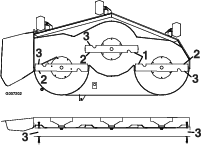
Checking the Front-to-Rear Blade Slope
Check the front-to-rear blade level any time you install the mower. If the front of the mower is more than 7.9 mm (5/16 inch) lower than the rear of the mower, adjust the blade level using the following instructions:
-
Park the machine on a level surface and disengage the blade control switch.
-
Move the motion control levers outward to the neutral position, engage the parking brake, stop the engine, remove the key, and wait for all moving parts to stop before leaving the operating position.
-
Carefully rotate the blades so they are facing front to rear (Figure 71).
-
Measure from the tip of the front blade to the flat surface and the tip of the rear blade to the flat surface (Figure 71). If the front blade tip is not 1.6-7.9 mm (1/16-5/16 inch) lower than the rear blade tip, continue to the Leveling the Mower Deck procedure.
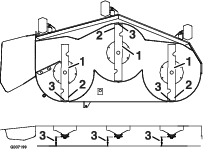
Leveling the Mower Deck
-
Set anti-scalp rollers to top holes or remove completely for this procedure; refer to Adjusting the Anti-Scalp Rollers.
-
Set the height-of-cut lever to the 76 mm (3 inch) position; refer to Adjusting the Height-of-Cut.
-
Place two 6.66 cm (2-5/8 inch) blocks under each side of the front edge of the deck, but not under the anti-scalp roller brackets (Figure 72).
-
Place two 7.30 cm (2-7/8 inch) thick blocks under the rear edge of the cutting deck skirt; one on each side of the cutting deck (Figure 72).

-
Loosen the adjustment bolts on all four corners so that the deck is sitting securely on all four blocks (Figure 73).
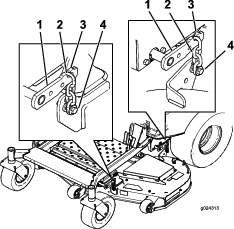
-
Ensure there is tension on all four chains(Figure 73).
-
Tighten the four adjustment bolts(Figure 73).
-
Check that blocks fit just snugly under the deck skirt. Make sure all bolts are tight
-
Verify that the deck is level by checking the side-to-side level and front-to-rear blade slope; repeat the deck leveling procedure if necessary.
Inspecting the Belts
| Maintenance Service Interval | Maintenance Procedure |
|---|---|
| Every 50 hours |
|
Check the belts for squealing when the belt is rotating, blades slipping when cutting grass, frayed belt edges, burn marks and cracks are signs of a worn mower belt. Replace the mower belt if any of these conditions are evident.
Replacing the Mower Belt
Squealing when the belt is rotating, blades slipping when cutting grass, frayed belt edges, burn marks and cracks are signs of a worn mower belt. Replace the mower belt if any of these conditions are evident.
-
Disengage the blade control switch (PTO), move the motion control levers to the neutral locked position and set the parking brake.
-
Stop the engine, remove the key, and wait for all moving parts to stop before leaving the operating position.
-
Lower the mower to the 76 mm (3 inch) height-of-cut position.
-
Loosen the bottom two bolts holding the mower-deck curtain to the mower deck. Refer to Releasing the Mower-Deck Curtain.
-
For each of the belt covers, loosen the two bolts but do not remove them. Slide the cover until it is clear of the bolts and lift it up and out to remove it.
-
Remove the floor pan to access the idler pulley; refer to the Removing the Floor Pan procedure in Premaintenance.
-
Using a spring removal tool, (Toro part no. 92-5771), remove the idler spring from the deck post to remove tension on the idler pulley (Figure 74).
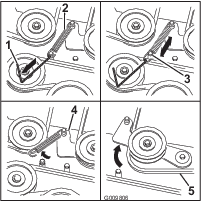
-
Lower the mower to the lowest height-of-cut. Place the height-of-cut pin in the lock position for lowest height-of-cut.
-
Remove the belt from the mower deck pulleys and remove the existing belt.
-
Install the new belt around the mower pulleys and the clutch pulley under the engine (Figure 74).
Warning
The spring is under tension when installed and can cause personal injury.
Be careful when removing the belt.
-
Using a spring removal tool, (Toro part no. 92-5771), install the idler spring over the deck post and placing tension on the idler pulley and mower belt (Figure 74).
-
Ensure that the belt is properly seated in all pulleys.
-
To install the belt covers, insert the tabs on the each cover into the corresponding slots on the deck bracket, ensuring that they seat. Rotate the cover to the deck and slide the notches under the loosened bolts until they are seated. Tighten the bolts to secure the cover to the deck.
-
Tighten the bottom two bolts holding the mower-deck curtain to the mower deck (Releasing the Mower-Deck Curtain).
Removing the Mower
Park the machine on a level surface and disengage the blade control switch. Move the motion control levers outward to the neutral position, engage parking brake, stop the engine, remove the key, and wait for all moving parts to stop before leaving the operating position.
Lower the mower to the lowest height-of-cut. Select one of the following procedures depending on the mower deck size installed to complete the removal.
Preparing to Remove the Mower Deck
-
Lower the mower to the 76 mm (3 inch) height-of-cut position.
-
Loosen the bottom two bolts holding the mower-deck curtain to the mower deck. Refer to Releasing the Mower-Deck Curtain.
-
Remove the mower belt from the engine pulley; refer to Replacing the Mower Belt.
Removing the Mower Deck
-
Remove the hair pin cotter and washer securing the long, link pin to the frame and deck; remove the link bar (Figure 75).

-
Lift up on the mower deck to relieve tension from the mower deck.
-
Remove the chains from the hooks on the deck lift arms (Figure 76).

-
Raise the height-of-cut to the transport position.
-
Remove the belt from the clutch pulley on the engine.
-
Slide the mower out from underneath the machine.
Note: Retain all parts for future installation.
Installing the Mower Deck
-
Park the machine on a level surface and disengage the blade control switch.
-
Move the motion control levers outward to the neutral lock position, stop the engine, remove the key, set the parking brake and wait for all moving parts to stop before leaving the operating position.
-
Slide the mower under the machine.
-
Lower the height-of-cut lever to the lowest position.
-
Place the height-of-cut pin in the lock position for lowest height-of-cut.
-
Lift the rear of the mower deck and attach the chains to the rear lift arms (Figure 76).
-
Attach the front chains to the front lift arms (Figure 76).
-
Install the long, link bar through the frame hanger and deck.
-
Secure the link pin with the hair pin cotters and washers removed previously (Figure 75).
-
Install the mower belt onto the engine pulley; refer to Replacing the Mower Belt.
-
Tighten the bottom two bolts holding the mower-deck curtain to the mower deck (Figure 41).
Replacing the Grass Deflector
| Maintenance Service Interval | Maintenance Procedure |
|---|---|
| Before each use or daily |
|
Warning
An uncovered discharge opening could allow the lawn mower to throw objects in the operator’s or bystander’s direction and result in serious injury. Also, contact with the blade could occur.
Never operate the lawn mower unless you install a mulch plate, discharge deflector, or grass collection system.
Inspect the grass deflector for damage before each use. Replace any damaged parts before use.
-
Remove the cotter pin from the end of the rod (Figure 77).
-
Disengage the spring from the notch in the deflector bracket and slide the rod out of the welded deck brackets, spring, and discharge deflector (Figure 77). Remove the damaged or worn discharge deflector.
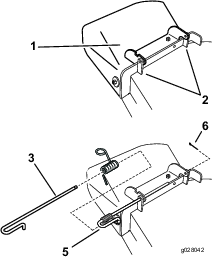
-
Position the new discharge deflector with the bracket ends between the welded brackets on the deck as shown in Figure 77.
-
Install the spring onto the straight end of the rod. Position the spring on the rod as shown in so the shorter spring end is coming from under the rod before the bend and going over the rod as it returns from the bend.
-
Lift the loop end of the spring and place it into the notch on the deflector bracket (Figure 78).
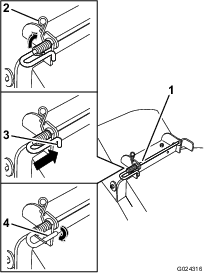
-
Secure the rod and spring assembly by twisting it so the short end of the rod can be placed behind the front bracket welded to the deck (Figure 78).
Important: The grass deflector must be spring loaded in the down position. Lift the deflector up to test that it snaps to the full down position.
-
Install the cotter pin into the end of the rod (Figure 77).
Cleaning
Washing the Underside of the Mower
| Maintenance Service Interval | Maintenance Procedure |
|---|---|
| After each use |
|
Wash the underside of the mower after each use to prevent grass buildup for improved mulch action and clipping dispersal.
-
Park the machine on a level surface and disengage the blade control switch.
-
Move the motion control levers outward to the neutral lock position, stop the engine, remove the key, and wait for all moving parts to stop before leaving the operating position.
-
Attach the hose coupling to the end of the mower washout fitting, and turn the water on high (Figure 79).
Note: Spread petroleum jelly on the washout fitting O-ring to make the coupling slide on easier and protect the O-ring.
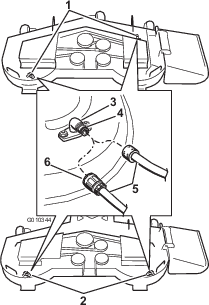
-
Lower the mower to the lowest height-of-cut.
-
Sit on the seat and start the engine. Engage the blade control switch and let the mower run for one to three minutes.
-
Disengage the blade control switch, stop the engine, and remove the ignition key. Wait for all moving parts to stop.
-
Turn the water off and remove the coupling from the washout fitting.
Note: If the mower is not clean after one washing, soak it and let it stand for 30 minutes. Then repeat the process.
-
Run the mower again for one to three minutes to remove excess water.
Warning
A broken or missing washout fitting could expose you and others to thrown objects or blade contact. Contact with blade or thrown debris can cause injury or death.
-
Replace broken or missing washout fitting immediately, before using mower again.
-
Never put your hands or feet under the mower or through openings in the mower.
-
Waste Disposal
Engine oil, batteries, hydraulic oil, and engine coolant are pollutants to the environment. Dispose of these according to your state and local regulations.
Storage
Cleaning and Storage
-
Disengage the blade control switch (PTO), set the parking brake, and turn the ignition key to Off. Remove the key.
-
Remove grass clippings, dirt, and grime from the external parts of the entire machine, especially the engine and hydraulic system. Clean dirt and chaff from the outside of the engine cylinder head fins and blower housing.
Important: You can wash the machine with mild detergent and water. Do not pressure wash the machine. Avoid excessive use of water, especially near the control panel, engine, hydraulic pumps, and motors.
-
Check the parking brake operation; refer to Operating the Parking Brake.
-
Service the air cleaner; refer to Servicing the Air Cleaner.
-
Grease the machine; refer to Lubrication.
-
Change the crankcase oil; refer to Changing the Engine Oil.
-
Check the tire pressure; refer to Checking the Tire Pressure.
-
Change the hydraulic filter; refer to Changing the Hydraulic System Filter and Oil.
-
Charge the battery; refer to Charging the Battery.
-
Scrape any heavy buildup of grass and dirt from the underside of the mower, then wash the mower with a garden hose.
Note: Run the machine with the blade control switch (PTO) engaged and the engine at high idle for 2 to 5 minutes after washing.
-
Check the condition of the blades; refer to Servicing the Cutting Blades.
-
Prepare the machine for storage when non-use occurs over 30 days. Prepare the machine for storage as follows:
-
Add a petroleum based stabilizer/conditioner to fuel in the tank. Follow mixing instructions from the stabilizer manufacturer. Do not use an alcohol based stabilizer (ethanol or methanol).
Note: A fuel stabilizer/conditioner is most effective when mixed with fresh fuel and used at all times.
-
Run the engine to distribute conditioned fuel through the fuel system (5 minutes).
-
Stop the engine, allow it to cool, and drain the fuel tank.
-
Restart the engine and run it until it stops.
-
Dispose of fuel properly. Recycle the fuel according to local codes.
Important: Do not store stabilizer/conditioned fuel over 90 days.
-
-
Check and tighten all bolts, nuts, and screws. Repair or replace any part that is damaged.
-
Paint all scratched or bare metal surfaces. Paint is available from your Authorized Service Dealer.
-
Store the machine in a clean, dry garage or storage area. Remove the key from the ignition switch and keep it out of reach of children or other unauthorized users. Cover the machine to protect it and keep it clean.
Troubleshooting
| Problem | Possible Cause | Corrective Action |
|---|---|---|
| Starter does not crank |
|
|
| Engine will not start, starts hard, or fails to keep running |
|
|
| Engine loses power. |
|
|
| Engine overheats. |
|
|
| Mower pulls left or right (with levers fully forward) |
|
|
| Machine does not drive. |
|
|
| Abnormal vibration. |
|
|
| Uneven cutting height. |
|
|
| Blades do not rotate. |
|
|
Schematics
Wire Diagram
